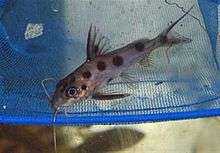Synodontis notatus
| Synodontis notatus | |
|---|---|
 | |
| Scientific classification | |
| Kingdom: | Animalia |
| Phylum: | Chordata |
| Class: | Actinopterygii |
| Order: | Siluriformes |
| Family: | Mochokidae |
| Genus: | Synodontis |
| Species: | S. notatus |
| Binomial name | |
| Synodontis notatus Vaillant, 1893 | |
Synodontis notatus, known as the onespot squeaker,[1] the one-spot synodontis,[2] or the domino syno,[3] is a species of upside-down catfish native to the Congo Basin of the Democratic Republic of the Congo, and the Republic of the Congo.[1] It was first described by French zoologist Léon Vaillant in 1893.[2] The specific name "notatus" comes from the Latin word for "marked", as with a spot.[2]
Description
The body of the fish is greyish-brown to olive colored on the back, with a gold sheen on the operculum. The ventral surface is light colored. Most individuals will have a single, dark spot, but some may display multiple spots or no spots, and may not have the same number on each side.[2][3] The spots do not grow as the fish grows, so they will appear smaller in adults.[2]
Like other members of the genus, this fish has a humeral process, which is a bony spike that is attached to a hardened head cap on the fish and can be seen extending beyond the gill opening.[3] The first ray of the dorsal fin and the pectoral fins have a hardened first ray which is serrated.[3] The caudal fin is deeply forked.[3] It has short, cone-shaped teeth in the upper jaw.[3] In the lower jaw, the teeth are s-shaped and movable.[3] The fish has one pair of long maxillary barbels, extending far beyond the operculum, and two pairs of mandibular barbels that are often branched.[2][3] The small adipose fin is set far back.[2]
This species grows to a length of 25 centimetres (9.8 in) SL although specimens up to 26.5 centimetres (10.4 in) TL have been recorded in the wild.[1][3]
Habitat
In the wild, the species inhabits tropical waters with a temperature range of 22 to 26 °C (72 to 79 °F), a pH of 6.0 – 7.5, and dH range of 4-15.[1] It has been found throughout the Congo River basin. It has also been found in the upper Kasai River systems, the Lufira River system, and the Luapula River system.[4]
References
- 1 2 3 4 Froese, Rainer and Pauly, Daniel, eds. (2016). "Synodontis notatus" in FishBase. June 2016 version.
- 1 2 3 4 5 6 7 "Synodontis notatus Vaillant, 1893". scotcat.com. Retrieved 17 October 2016.
- 1 2 3 4 5 6 7 8 9 "Synodontis notatus Vaillant, 1893". Planet Catfish. 19 Jul 2013. Retrieved 17 October 2016.
- ↑ Moelants, T. (2010). "Synodontis notatus". IUCN Red List of Threatened Species. Version 2016.2. International Union for Conservation of Nature. Retrieved 17 October 2016.
External links
![]() Data related to Synodontis notatus at Wikispecies
Data related to Synodontis notatus at Wikispecies
